Menus
- On the move with air-cooled big bikes
- Kawasaki GPZ 1100 UT
- GPZ always pulls your arms out
- Respectable deceleration with a single piston floating caliper brake
- Laverda RGS 1000
- Has to be kept happy with bursts of gas
- Rapid changes in lean angle are unexpectedly easy
- Suzuki GSX 1100 EF
- Muscle-packed, tattooed body builder
- Somewhat dull looking brake
- The sporty one: Kawasaki GPZ 1100 UT
- technology
- Used check
- market
- Technical specifications
- history
- The extravagant: Laverda RGS 1000
- technology
- Used check
- market
- Technical specifications
- history
- The balanced one: Suzuki GSX 1100 EF
- technology
- Used check
- market
- Technical specifications
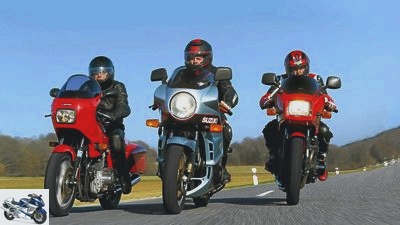

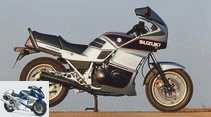
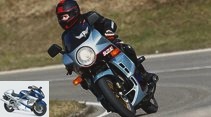

48 photos
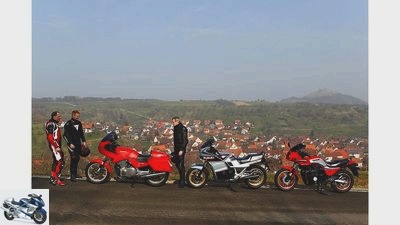
1/48
The engines are the stars, they still exude charm and, in the case of GPZ, RGS and GSX, clearly make you want more. More days like this, when the drivers reminiscing about their memories let the wind blow around their noses and the engines around the cooling fins.
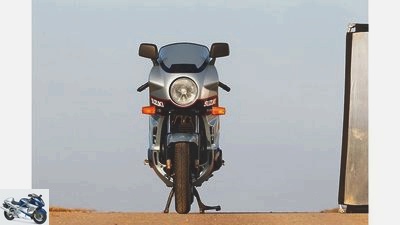
2/48
No wonder that the open foreign version made a whopping 115 hp.
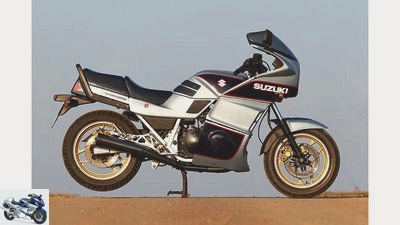
3/48
The GSX four-valve engine, which has been known for its beefy character since 1980, finally got a displacement increase for the GSX 1100 EF, which was launched in 1984 – 74 instead of 72 millimeters bore lifts the same from 1075 to 1135 cm³.
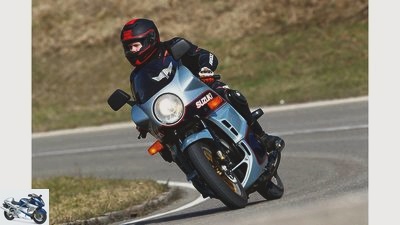
4/48
The whole concept of the Suzuki GSX 1100 EF with its massive full fairing and idiosyncratic angular design conveys the least sporty flair of the three candidates. But she has it sore under the tank.

5/48
Who didn’t gobble up the first test reports back then, stare after the first specimens seen in the wild with an open mouth and can still sometimes pray down the impressive readings in their sleep?
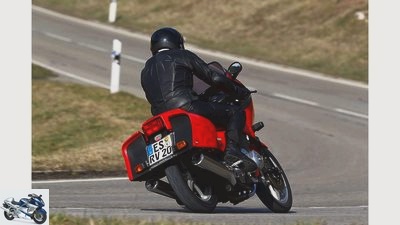
6/48
After a short time getting used to the necessary driving style, the Italian is definitely a lot of fun.
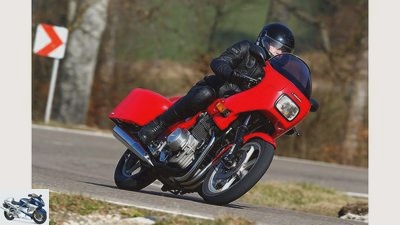
7/48
The triplet is already warm, starts spontaneously, but has to be kept happy with throttle thrusts.
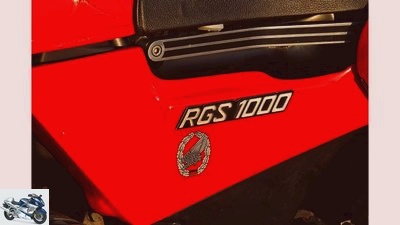
8/48
Only rarely does someone give his RGS or even its noble sister model RGS Corsa or SFC. Only 1,300 copies of the RGS were reportedly built, plus 50 executive versions.
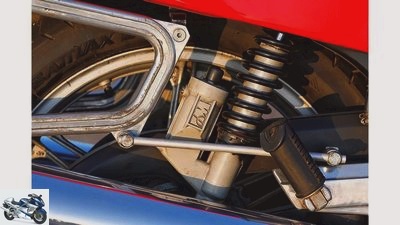
9/48
The suspension of the Laverda RGS 1000.
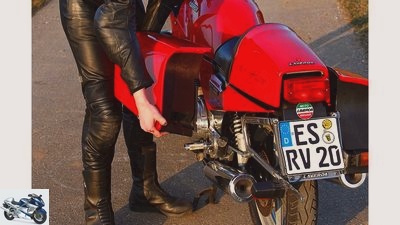
10/48
Sophisticated construction: The indicator brackets can be folded down, the narrow cases can then be easily dismantled.
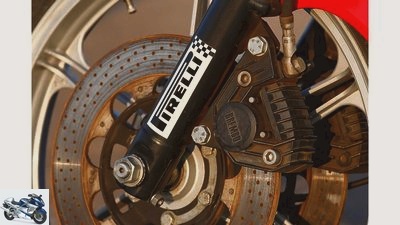
11/48
The front wheel of the Laverda RGS 1000.
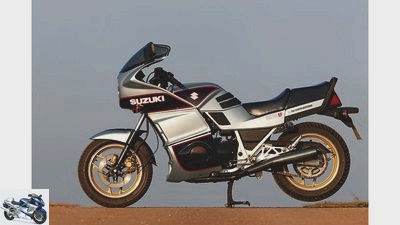
12/48
The Suzuki GSX 1100 EF can do both – country and western: With its compact dimensions and a small 16-inch front wheel, the Japanese can not only move around in a sporty way, but thanks to its comfortable seating position and effective paneling is also suitable for long tours.
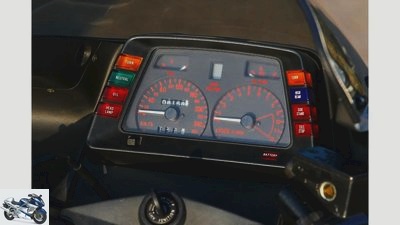
13/48
Big cinema: lots of warning lights, even a gear indicator, but the speedometer and tachometer scales that are too small.
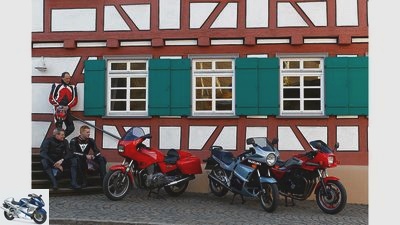
14/48
Power plant meets half-timbered structure: All examples show that there were clever ideas and bear forces even earlier.
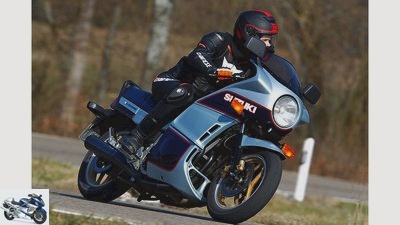
15/48
You can come to terms with the somewhat blunt-looking brake, which calls for the whole paw to be grasped. Fork and full floater system do their job properly, no excessive hardness, no overly soft rocking – that’s okay.
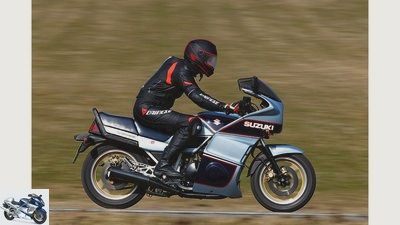
16/48
The 16-inch device at the front proves to be the expected guarantee of handiness and easy turning, without annoying the usual disadvantages such as standing up when braking or tilting.
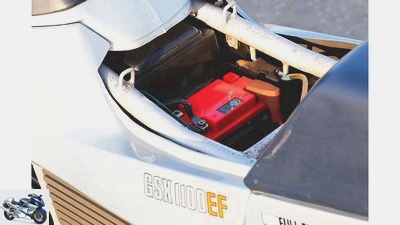
17/48
But if this is gone, the battery is easy to access.
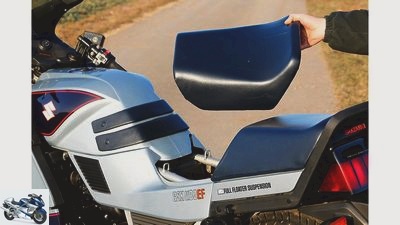
18/48
Only the driver’s seat bun can be unlocked and removed to access the battery.

19/48
The immersion delay, which no longer wants to be anti-dive, only works moderately on the complex fork.
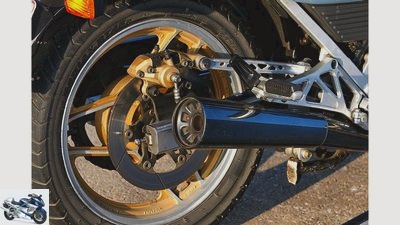
20/48
The exhaust of the Suzuki GSX 1100 EF.
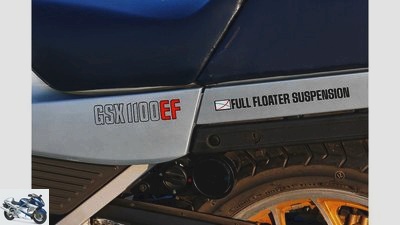
21/48
Two wheels, one shock absorber: the preload (right) can be continuously adjusted, the damping (left) can be adjusted four times.
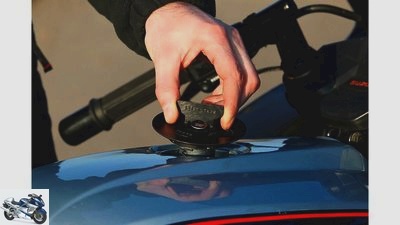
22/48
The fuel cap of the Suzuki GSX 1100 EF.

23/48
A lot of work for the left thumb: choke lever, horn and multi-function switch on the left handlebar end.

24/48
Smart solution: The footrest system can be adjusted to the driver’s preferred position using an eccentric.
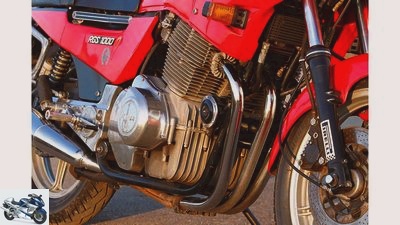
25/48
The three-cylinder shines with its solid construction and durability, only the oil change intervals are very short.
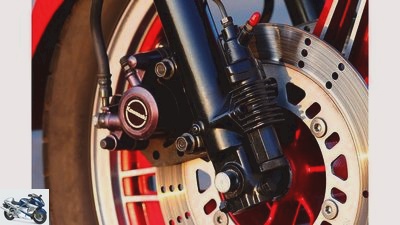
26/48
The front wheel of the kawasaki GPZ 1100 UT.
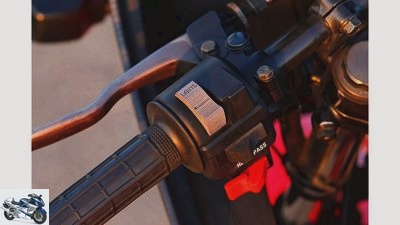
27/48
The large, somewhat coarse-looking switches look a bit like from the Lego construction kit.
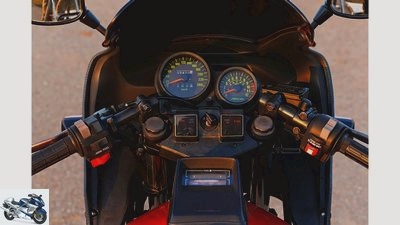
28/48
Small round clocks in the cockpit, but many warning lamps that more or less reliably indicate malfunctions.
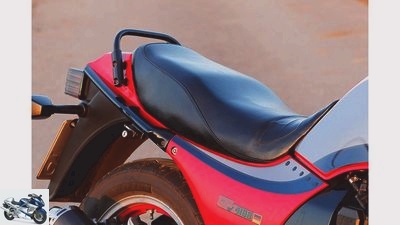
29/48
The prices are rising gradually, but the Kawa is only slowly developing into a real investment.
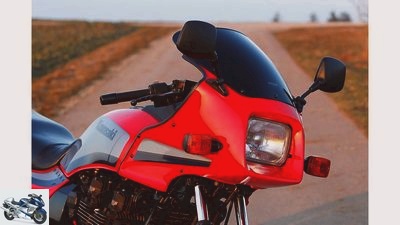
30/48
Finding a GPZ 1100 in good condition is hard enough.
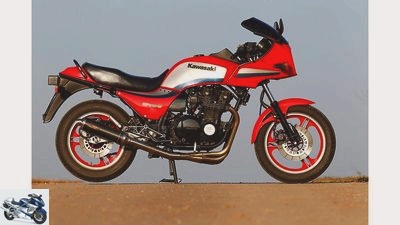
31/48
The two-valve engine, which goes back a long way in its basic design, still works with a crankshaft with five roller bearings.
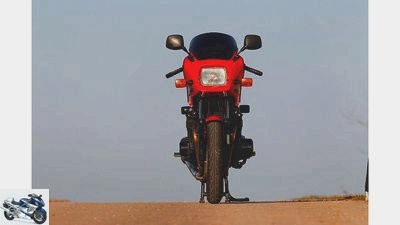
32/48
With a crouched appearance and an open 120 hp engine, the sportswoman of the big bike trio.

33/48
The model with the largest displacement in the GPZ series combines old but proven engine technology with a modern digital injection system.
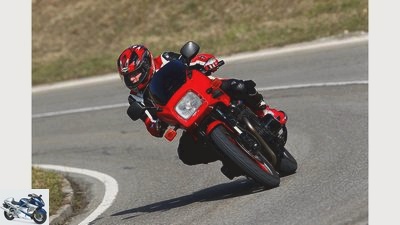
34/48
It starts with the Kawasaki GPZ 1100 UT.
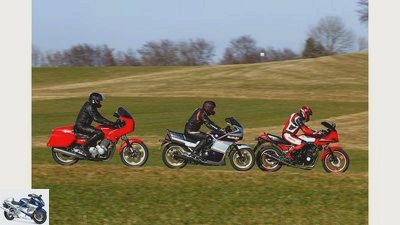
35/48
But we roll with our three representatives of this glorious time on this first sunny, warm spring weekend in the direction of the Swabian Alb. Blue sky – fits.
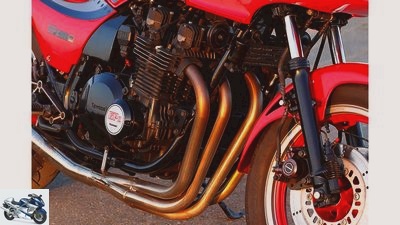
36/48
Black beauty: the classically ribbed engine is well presented and relies on an oil cooler.
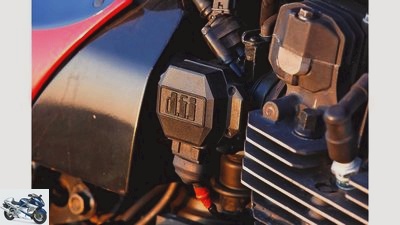
37/48
As early as 1983, the DFI unit had a light-emitting diode on the control unit that indicated errors by means of a flashing code.
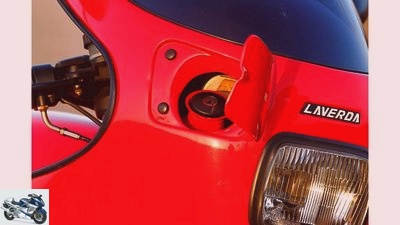
38/48
Where is the tank? Wherever he is. Only the filler neck in the front right in the half-shell is unusual.
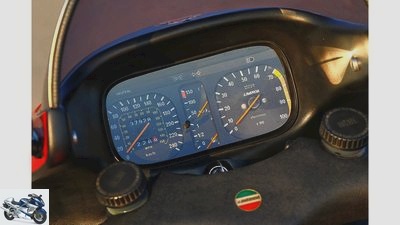
39/48
The compact, box-shaped cockpit could also have come from a car and has often been ridiculed.
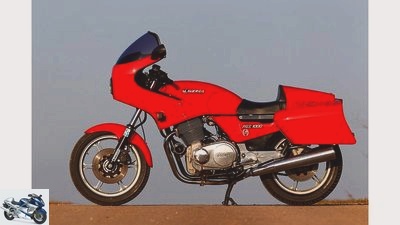
40/48
Small numbers and extravagant design guarantee individuality and exclusivity. The robust three-cylinder Italian is still not a sensitive show bike, but a sporty driving machine with astonishingly durable technology and great sound.
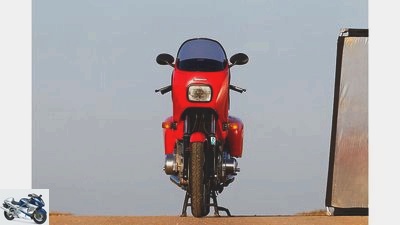
41/48
All in all enough for considerable performance, despite the impressive weight of 265 kilograms.
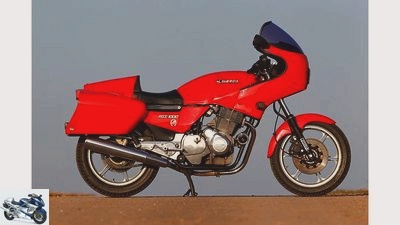
42/48
The initially somewhat optimistic performance figure of 91 hp had to be corrected to 83 hp for the German version, also because of the intake and exhaust noise values that had to be observed, of which 79 were measured on the test bench.
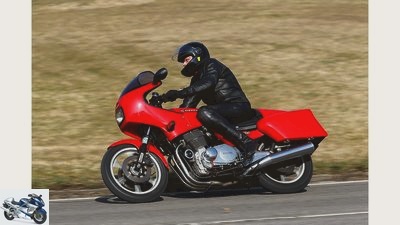
43/48
Laverda has always stood for modern solutions and a wealth of ideas – two overhead camshafts and bucket tappets were introduced here early on.
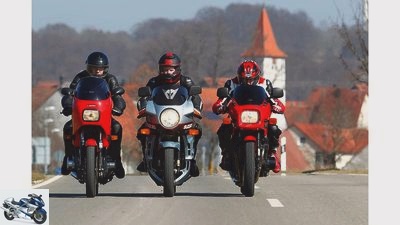
44/48
Towering high, crouching broadly or crouching flat – three different interpretations of the (disguise) style.
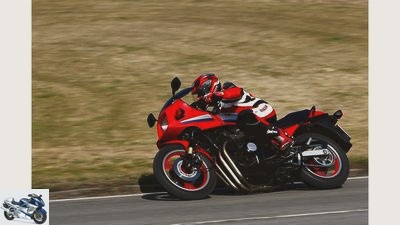
45/48
The Kawa quad hums wonderfully bassy and roars in a pleasantly sporty manner as the speed increases. Not too loud, but anything but shy.
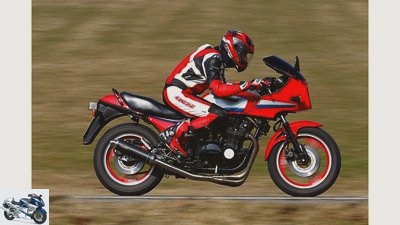
46/48
Apart from the bitchy cold running phase, the GPZ, which was recently overhauled by a professional (Bike Side company), is in top condition and, apart from the 4-in-1 system, also original.
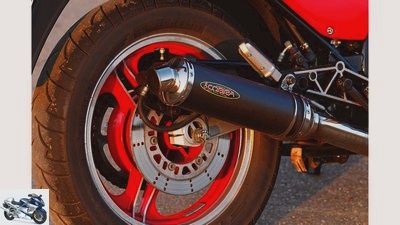
47/48
With the eccentric chain tensioner, Kawasaki had already installed a pioneering detail back then.
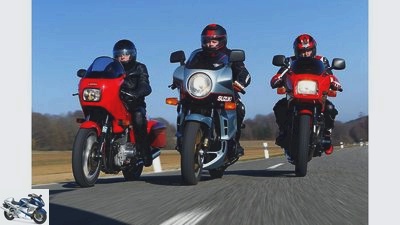
48/48
In winter it can freeze, in summer the cooler boils – no one needs water cooling. ”The arguments of fans of air-cooled engines sound convincing.
Kawasaki GPZ 1100 UT, Laverda RGS 1000 and Suzuki GSX 1100 EF
On the move with air-cooled big bikes
Content of
In the mid-1980s, they were among the threatened, powerful air-cooled big bikes – the future seemed to belong to water-cooled engines. MOTORRAD Classic blew GPZ, RGS and GSX around 30 years later, the wind around the engines again.
“In winter it can freeze, in summer the radiator boils – nobody needs water cooling.” The arguments of fans of air-cooled engines sound convincing. Okay, with an outside temperature of 30 degrees, a generously ribbed air-cooled motor panting after every cooling breeze when the rider torments his bike in the city from stop to stop.
Buy complete article
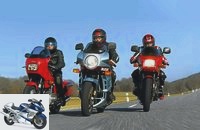
Kawasaki GPZ 1100 UT, Laverda RGS 1000 and Suzuki GSX 1100 EF
On the move with air-cooled big bikes
GSX 1100 EF. The abbreviations alone make the over 40s among us nod knowingly and look pensive – after all, GPZ, GSX and RGS stood long enough for mostly unfulfilled dreams. Who did not devour the first test reports back then, stare after the first specimens seen in the wild with their mouths open and can still sometimes pray down the impressive readings in their sleep? I confess – I was one of them. And today one or the other wish should come true.
Kawasaki GPZ 1100 UT
The Kawasaki GPZ 1100 UT, which was recently overhauled by professionals (Bike Side).
Starting with the Kawasaki GPZ 1100 UT – I’ve ridden most of the GPZ models at some point, but never the 1100s. Today it is ready, a loan from Ralph Schmitt, who bought his dream kawa four years ago and unfortunately cannot be part of the party today. Colleague Stefan likes to take on the role of the photo driver, as he is toying with a GPZ 1100 himself. Apart from the bitchy cold running phase (“The temperature sensor can say goodbye”, Ralph Schmitt admitted in advance), the GPZ, which was recently overhauled by professionals (Bike Side), is in top condition and except for the 4-in-1 -System also original. The well-preserved series 4-in-2 system is there, but re-tuning the injection to the modified exhaust system would be too time-consuming, says Schmitt.
In any case, it did not harm the sound, the Kawa quad hums wonderfully bassy while standing and roars in a pleasantly sporty manner with increasing speed. Not too loud, but anything but shy. The mechanical expressions of life of the older four-cylinder engine with its five-fold roller-bearing crankshaft are kept within limits. This should also apply to fuel consumption, this goal was at least behind the conversion of the injection from the Bosch L-Jetronic, reproduced under license, of the first GPZ model B1 from 1981 to the significantly improved DFI system with fuel cut-off, which was introduced in 1982 found its way into B2.
GPZ always pulls your arms out
The space requirement and the structural effort could be reduced and the hot start behavior improved. The engine is great at the gas, reacts spontaneously and willingly to the twist of the throttle even below 2000 rpm and pulls the whole load forward with power. Not as snappy as its predecessor, they say, because the 1983 version was trimmed to the full (foreign) peak power of 120 hp by means of longer control times and larger valves, at the expense of pulling through from the bottom. But to complain about it would be whining on a high level. The Kawasaki GPZ 1100 UT pulls your arms out at any time, it’s good that you are stretched out in a sporty manner, but still fit for long distances. The seating position fits immediately, the notches are not too high, the handlebars are not too low and are pleasantly cranked – ideal conditions for fast stretches of the motorway.
Length runs, the lush wheelbase and the chassis geometry let the Kawasaki GPZ 1100 UT burn stable over the track. Well, if you do not duck behind the flat pane at over 180 km / h, you will cause a light front and harvest very light stirring. But if you want to enjoy some wind protection at all, you tend to voluntarily adopt the racing stance. Steady straight ahead, but not around the corner? Not at all. The 1100 is surprisingly light-footed and agile, despite the 18-inch front wheel. Turning in and quick changes of lean angle are not part of the work, you think you are on a nimble 750. Nobody needs to have exaggerated respect for the sheer size of the Kawa once the GPZ is rolling. In any case, the red one is far from the proverbial iron pig.
Respectable deceleration with a single piston floating caliper brake
Still: 266 kilograms plus the driver want to be decelerated, at least I have that in the back of my head when braking into the first hairpin and grab the brake lever courageously and rather early. The caution turns out to be unfounded with the Kawasaki GPZ 1100 UT, because even with two fingers you can elicit a respectable deceleration from the aged single-piston floating caliper brake. The effect and dosage are still impressive today. respect.
Speaking of showing: If the Kawasaki GPZ 1100 UT with its sleek lines and the pretty red painted cast wheels is an eye-catcher anyway, even the futuristic-looking mouse cinema on the tank fits the contemporary appearance. The electronics and especially the numerous sensors and plug-in contacts of the GPZ are also a well-known source of error messages, which do not always have to be a real error. I could live with it very well, and Stefan also sums up thoughtfully: “You could get used to the car …”
Laverda RGS 1000
The Laverda RGS 1000 is unusual from the engine concept to the position of the tank filler neck to various equipment details.
Get used to it, yes, usually, no – one could imagine the Laverda RGS 1000 like this or similar, which wants to take on the two Japanese women today as it was then. Starting with the engine concept (a three- instead of four-cylinder), through the position of the tank filler neck to various equipment details – unusual. Owner Thorsten Helmcke has always been particularly fascinated by this unusual feature of Laverdas and the RGS 1000. His RGS was one of the first to be built at the end of 1981 / beginning of 1982. The cases come from the special Executive model, which has only been built around 50 times, the IT manager bought them second-hand and installed them later.
The late 1000 cc three-cylinder is one of the most robust and long-lasting engines from Breganze. Unlike the previous triplets with the 180-degree motors, Laverda relies on a crankpin offset of 120 degrees from year of construction 1982, all housings and bearings are extremely generously dimensioned, as if the company boss and triple fan Massimo Laverda and the engineer Luciano Zen wanted to join them the solid construction remind of the tradition of the company, which was founded as an agricultural machinery manufacturer. But Laverda has always stood for modern solutions and a wealth of ideas – two overhead camshafts and bucket tappets were introduced here early on. The initially somewhat optimistic performance figure of 91 hp had to be corrected to 83 hp for the German version, also because of the intake and exhaust noise values that had to be observed, of which 79 were measured on the test bench.
Has to be kept happy with bursts of gas
All in all enough for considerable performance, despite the impressive weight of 265 kilograms. Which are clearly noticeable right from the start when maneuvering – the high center of gravity makes the Laverda RGS 1000 look even heavier. When you sit up, you notice the pleasantly low seat height, the driver’s arms automatically stretch over the flat tank to the narrow, slightly cranked handlebar stubs, the legs have to be folded tightly to find space on the sporty footrests. We don’t use the smart option of setting the notches mounted on an eccentric today – let’s go. The triplet is already warm, starts spontaneously, but has to be kept happy with throttle blows. “The RGS never idled,” admits Helmcke. “I’ve got used to it, but I’ll answer it again at some point.”
The fact that the throttle grip, like the clutch lever, is stiff doesn’t make things any easier, but on the country road this shortcoming doesn’t bother at first. Amazingly cultivated, mechanically and acoustically, the triplet of the Laverda RGS 1000 goes to work, hardly anything of the expected vibrations can be felt, and the sound also sounds rather subtle. The marvelously pithy three-cylinder tubing occurs at medium speeds, but remains cautious. Just like the performance development in the lower area does not come across as solid or even silky. The triple needs revs and can do this, it really gets going between 5000 and 6000 / min, then seems to feel comfortable and admittedly in the cockpit warns to moderate already from 7000 / min, but delivers its maximum performance only at 8000 revolutions.
Rapid changes in lean angle are unexpectedly easy
In case of doubt, shift down a gear before the bend and accelerate out with enough speed. The five-speed gearbox shines with properly engaging steps, albeit long shifting travel, and works unobtrusively, so I can concentrate on choosing the right line and the braking point. The Brembo calipers take the perforated cast disks neatly in their pliers, but require a firm grip and you miss a bit of the real bite. On the other hand, turning in turns out to be a relatively casual affair, requires little effort and the Laverda RGS 1000 does not wobble even in an inclined position. Even quick changes of lean angle are unexpectedly easy.
The high center of gravity is only noticeable when braking hard into tight bends, and the Laverda RGS 1000 wants to push the front wheel out of the curve. The Marzocchi suspension elements don’t seem as tough as their reputation to me, at least the fork does its job quite well, the rear is sporty and tight, but with acceptable hardness. After a short time getting used to the necessary driving style, the Italian is definitely a lot of fun. I’m relieved – so it not only looks good, which I admired it for when it was released, but is actually the driving machine that Laverda fans love it for. Really good sports tourer, or what does the type designation RGS stand for? Officially, von Laverda always said it was the abbreviation for Real Gran Sports, but insiders actually see it as the abbreviation for the design studio “Ricciuti Giuseppe Studio” in Rome, which was commissioned with the design at the time.
Suzuki GSX 1100 EF
The whole concept of the Suzuki GSX 1100 EF with its massive full fairing and idiosyncratic angular design conveys the least sporty flair.
What GSX means seems clearer: Grand Sport, the X stands for 4 Valve, i.e. four-valve technology. But the sportiness of the Suzuki GSX 1100 EF is not that grand – at least it makes switching from the Laverda easy. Take a seat – relaxed leg posture, wide, comfortably high handlebar stubs, that’s how long tours can be casually rewound.
The whole concept of the Suzuki GSX 1100 EF with its massive full fairing and idiosyncratic angular design conveys the least sporty flair of the three candidates. But she has it as a sly under the tank. The GSX four-valve engine, which has been known for its beefy character since 1980, finally got a displacement increase for the GSX 1100 EF, which was launched in 1984 – 74 instead of 72 millimeters bore heave the same from 1075 to 1135 cm³. As if that weren’t enough, the engine was given even larger intake valves, expanded intake ports and a compression ratio that was increased from 9.5 to 9.7: 1. No wonder that the open foreign version made a whopping 115 hp. Tamer camshafts turned it into the 100 hp required for Germany at the time, with fortunately hardly a lower torque value. Which led to the fabulous value of 8.3 seconds that I always remembered for the passage from 60 to 140 km / h in the last gear.
Muscle-packed, tattooed body builder
Admittedly, I found the Suzuki GSX 1100 EF when it was released, well, not particularly pretty, but this value earned me respect and aroused desires. Today I find their looks wonderfully flashy and I wouldn’t be ashamed of a copy in my garage.
Nico Ewe, who came with his father and his Suzuki GSX 1100 EF in tow, sees it similarly. Nico himself drives a naked GSX 1100 E, moving the father’s EF for the photo today with almost virgin 8,100 kilometers on the clock. So the 23-year-old knows the qualities of the beefy four-valve engine. After a break, I take over the Suzuki, the engine has cooled down again and asks for choke help. So there it is, the always rebuked howling during a cold start that calls for immediate readjustment. The engine hums to itself, very subtle in volume, accompanied by a slight howling whistle. From the beginning he makes it clear who wants to be the boss in the ring. With pithy vibrations, especially between 3000 and 6000 tours, the 1135 seems to want to mark its territory like a muscle-packed, tattooed body builder in an undershirt who can hardly walk with strength.
In doing so, the GSX engine grabs gently and decisively just above idle, increases its power incredibly evenly and actually never needs to be turned over 6000 tours, whereby the full 100 horses only gather at 8100 rpm and up to 9000 rpm allowed are. It also remains stress-free when it comes to the chassis, even with brisk country roads. The 16-inch device at the front proves to be the expected guarantee of handiness and easy turning without annoying with the usual disadvantages such as standing up when braking or wobbling. Everything stays relaxed, only the tendency to slide over the front wheel seems to be shared with the RGS.
Somewhat dull looking brake
And once the Suzuki GSX 1100 EF wedges violently with the handlebars during a casual, one-handed stroll downhill while pushing. So bitchy after all? The occasionally criticized commuting at high speed remains hidden from me, at least today, the wind protection proves to be pleasantly good. You can come to terms with the somewhat blunt-looking brake, which calls for the whole paw to be grasped. Fork and full floater system do their job properly, no excessive hardness, no overly soft rocking – that’s okay. You can feel just as much of the new type of anti-immersion device when braking as it was with the anti-dive – practically nothing.
It would be unfair to see the Suzuki GSX 1100 EF as an example of the so often cited phenomenon of the 70s and 80s bikes – “strong engines in overburdened chassis”. The conclusion of our trio is by no means that blatant, but the saying seems understandable today. The engines are the stars, they still exude charm and, in the case of GPZ, RGS and GSX, clearly make you want more. More days like this, when the drivers reminiscing about their memories let the wind blow around their noses and the engines around the cooling fins.
The sporty one: Kawasaki GPZ 1100 UT
The model with the largest displacement in the GPZ series combines old but proven engine technology with a modern digital injection system.
technology
The two-valve engine, which goes back a long way in its basic design, still works with a five-way roller-bearing crankshaft – those who had hoped for plain bearings when the original 1100 was presented in model year 1981 were disappointed. The all-black four-cylinder remains a rough running fellow, but the vibrations are within acceptable limits. After all, the 1100 was able to shine from the start with an injection system, initially with a license replica of the Bosch L-Jetronic borrowed from the car industry, in 1982 the much more modern map-controlled DFI system with numerous sensors and computers instead of the simple air flow meter and fuel cut-off was introduced. The injection nozzles migrated from the cylinder head into the throttle body – the former hot start problems due to the formation of steam bubbles were successfully resolved. The DFI system was again slightly modified for the Unitrak models from 1983 onwards.
In this version, which was built to the last, the GPZ was also tuned for maximum performance, after all, impressive 120 hp in the foreign version. With a longer wheelbase, smaller wheels (18- / 17-inch front / rear instead of 19- / 18-inch) and the new Unitrak suspension with central spring strut, the chassis quality could be improved, especially the new frame-fixed half-shell instead of the handlebar-fixed cockpit fairing Significantly less front wheel and thus contributed to the improved high-speed stability.
Used check
Finding a GPZ 1100 in good condition is hard enough. The processing quality was unfortunately not the very best until the end of the construction period. Corrosion is definitely an issue, and rusting exhaust systems are more the rule than the exception. Even the sometimes moderate paint quality only rarely resisted the brown plague permanently, and attention should always be paid to screwed up threads or torn off studs. Oil leaks are quite obvious, be it on the cylinder base or the valve cover gasket.
The 1100 not only lets the oil leak out, it also burns it abundantly. A consumption of up to two liters per 1000 kilometers is still described by some as tolerable, but specialists warn that from a liter of oil consumption onwards, caution and an early overhaul with revision of the valve guides and replacement of piston rings and pistons. Especially after a long period of time, the numerous sensors and plugs can ensure time-consuming and unnerving troubleshooting until the GPZ runs clean again. A scruffy side stand contact that causes funny flashing signals in the tank display is still considered harmless. Spare parts are sometimes difficult or impossible to get, but specialists can still get a lot through global contacts or provide used parts.
market
The range of GPZ 1100 UT specimens is not large, and the range of well-groomed babies is actually very meager. The prices are rising gradually, but the Kawa is only slowly developing into a real investment. There are already repainted craft stalls for three-digit euro amounts, usable bikes usually range between 1,500 and 3,000 euros, even top specimens currently hardly fetch more than 4,000 euros.
Specialists
Bike side
Telephone 0 72 45/10 88 23
www.bikeside.de
Clubs and forums
www.gpz1100ut.de
www.1100ut.de
www.kawasaki-z.de
Technical specifications
Engine: Air-cooled four-cylinder four-stroke in-line engine, two overhead camshafts, two valves per cylinder, actuated via bucket tappets, displacement 1075 cm³, output 74 kW (100 PS) at 8750 rpm
Power transmission: Multi-disc oil bath clutch, five-speed gearbox, chain drive
Landing gear: Double loop frame made of tubular steel, telescopic fork, Ø 37 mm, two-arm swing arm made of aluminum, central spring strut, cast aluminum wheels, tires 110/90 V 18 front, 130/90 V 17 rear, double disc brake front, Ø 285 mm, single-piston floating calipers, disc brake rear, Ø 270 mm
Mass and weight: Wheelbase 1565 mm, weight with a full tank of 266 kg
Driving performance: Top speed 228 km / h
history
1981: The first, uncovered version of the 1100 (B1) with the “bread box” cockpit still has to get by with the L-Jetronic from Jecs under Bosch license.
Price: 10,360 marks
1982: A year later, the B2 was significantly improved with a handlebar-mounted cockpit fairing, new pistons and new, digitally controlled injection (DFI).
Price: 10,700 marks
The extravagant: Laverda RGS 1000
The initially somewhat optimistic performance figure of 91 hp had to be corrected to 83 hp for the German version, also because of the intake and exhaust noise values that had to be observed, of which 79 were measured on the test bench.
technology
The 1000cc three-cylinder with 180-degree crankshaft already looked back on around ten years of history (however, it was only presented on the German market in 1975) when the 180-degree solution was switched to the new design with a 120 degree crank pin offset in Breganze . First from mid / late 1981 in the Jota, then in the brand new RGS 1000 offered in 1982. It still combines solid construction and modern technology in a fascinating way: In all essential components very generously and therefore long-lasting dimensions (housing, bearing), with roller bearings Crankshaft, two overhead camshafts, bucket tappets, underlying shims and some other clever details with quite advanced technology.
The problems of early triplets with the alternators that are too weak are alien to the RGS with the 250 watt component. However, the standard contactless Bosch ignition system, which has practically only two static ignition points and regulates to maximum advance ignition even at low engine speed, often causes concern, which makes it difficult or impossible to achieve even power delivery and stable idling. A digital map ignition from DMC, which is available for around 400 euros, is recommended and already installed by many. You can live well with the tight Marzocchi spring elements in view of the stable driving behavior, experts recommend not to adjust the steering head bearing too tightly, rather easily, almost on the verge of rattling, in favor of good turning and cornering behavior.
Used check
In general, the Laverda treble is very robust and durable, 100,000 kilometers and more are usually not a problem. Engine damage is rare, at best high continuous speeds can lead to overheated heads and cracks in individual cases, and damage from cracks on the web of the timing chain slot has also been reported. Regular oil changes every 2500 kilometers are very important because the three-cylinder does not have an oil filter, but only a large-meshed metal sieve.
If dirt in the oil becomes gelatinized on the oil baffles of the crankshaft or the oil cooler clogs, the consequences are foreseeable. Overall, the generally well-made RGS with carefully laid electrics hardly suffers from any real weak points and is considered by experts to be one of the best Laverda types ever built. Used RGS are usually offered in very good condition. The well-networked Laverda community and some lively dealers of the brand ensure that almost all spare parts, especially wear parts, are available; if necessary, specialists like Andy Wagner (Laverda-Paradies in Konstanz) simply have parts reproduced in small series.
market
Only rarely does someone give his RGS or even its noble sister model RGS Corsa or SFC. Only 1,300 copies of the RGS were reportedly built, plus 50 executive versions. The price is difficult to quantify, even bikes in need of repair will hardly be found below 3000 to 4000 euros. Good specimens change hands from around 7000 to 8000 euros, and well-groomed sweethearts (Corsa and SFC anyway) can even reach five-figure amounts.
Specialists
Laverda paradise
Telephone 075 31/6 11 98
www.laverda-paradies.de
Orange cycle team
Telephone 022 51/97 07 52
www.octeam.de
Clubs and forums
www.laverda-gemeinschaft-deutschland.de
www.laverda-register.de
Technical specifications
Engine: Air-cooled three-cylinder four-stroke in-line engine, two overhead camshafts, two valves per cylinder, actuated by bucket tappets, displacement 981 cm³, output 61 kW (83 hp) at 8000 rpm
Power transmission: Multi-disc oil bath clutch, five-speed gearbox, chain drive
Landing gear: Double loop frame made of tubular steel, telescopic fork, Ø 38 mm, two-arm swing arm with two spring legs, aluminum-
Cast wheels, tires 100/90 V 18 at the front, 120/90 V 18 at the rear, double disc / disc brakes front / rear with fixed calipers,
Ø 280 mm
Mass and weight: Wheelbase 1520 mm, steering head angle 61 degrees, weight with a full tank of 265 kg
Driving performance: Top speed 209 km / h
history
1981: The Jota, which was built from 1976, was given a lush half-shell for the 1981 model year. What they all have in common is the last 80 hp 180-degree triplet.
Price: 12,500 marks
1982: Slightly modified, with new color variants, but above all with the new, somewhat more powerful 120-degree engine, the Jota enters the 1982 model year.
Price: 12,688 marks
The balanced one: Suzuki GSX 1100 EF
The GSX four-valve engine, which has been known for its beefy character since 1980, finally got a displacement increase for the GSX 1100 EF, which was launched in 1984 – 74 instead of 72 millimeters bore lifts the same from 1075 to 1135 cm³.
technology
The four-cylinder first saw the light of day in 1980 in the GSX 1100 E. Four valves promise progressive technology, but with the crankshaft with roller bearings and a cable-operated clutch instead of a hydraulic clutch, the claim has to be revised a bit. For the 1100 models from 1984 onwards (the EF opened, the naked E version and the semi-faired ES followed in 1985 and 1986, respectively), the engine was given a displacement of 1135 cm³ by changing the bore (74 instead of 72 millimeters). In addition, the intake valves were enlarged by two to 34.5 millimeters, the intake ports were enlarged (28 instead of 27 millimeters), the Big Block was given 36 instead of the previous 34 carburettors and the compression was increased from 9.5 to 9.7: 1.
In the open foreign version this was enough for a hefty 115 hp, for Germany it had to be throttled back to 100 hp by means of tamer control times and a modified exhaust. A reinforced clutch and more stable piston pins (20 instead of 18 millimeters) as well as an oil cooler, with the insertion of which the oil supply increased by 300 cm³, ensured greater stability. The frame is also new – a construction of round tubes at the top with rectangular beams, an adjustable central spring strut (full floater system) to ensure stability and comfort on the hindquarters. The front fork dispenses with the previous, rather useless anti-dive and now tries to prevent too much immersion when braking via four-way adjustable compression damping.
Used check
Basically, Suzuki’s air-cooled 1100 series, especially the last expansion stage, enjoy a good reputation as stable, long-lasting engines. Coupling problems or even hairline cracks in the cylinder head that occurred with the 1075 engines at the beginning are a thing of the past with the 1135 thanks to the oil cooler. Oil is still an issue: with increasing mileage, lubricant consumption usually rises significantly – the cause of the problem is that the oil control rings on the pistons are too thin and wear out quickly. Occasionally, the wrong oil or sloppy valve clearance adjustment also resulted in heavy stress on the hard chrome layer of the fork rocker arms.
If this layer flakes off, the camshafts will be damaged. Technical and wear parts can usually still be found somehow for the GSX, but it can gradually get tight when it comes to fairing and add-on parts. When browsing the net, it is advisable to expand your search to worldwide or to contact well-networked youngtimer specialists who often specialized in the air-cooled Japan bikes of the 1980s (often across all brands).
market
Between the old GS 1000, the original versions of the GSX 1100 and the Katana models, the series from 1984, whether E, ES or EF, ekes out a kind of wallflower existence. Not many can get used to the design, the small number of machines still recorded (almost 150 according to KBA) is in firm hands. If one is offered, the demand is limited – you can get hold of well-preserved copies for (sometimes significantly) less than 2000 euros.
Specialists
Old school superbikes
Telephone 0 45 41/85 79 99
www.old-school-superbikes.de
Bike side
Telephone 0 72 45/10 88 23
www.bikeside.de
Clubs and forums
www.suzuki-classic.de
www.suzukicycles.org
Technical specifications
Engine: Air-cooled four-cylinder four-stroke in-line engine, two overhead camshafts, four valves per cylinder, operated via fork rocker arms, displacement 1135 cm³, output 74 kW (100 PS) at 8100 rpm
Power transmission: Multi-disc oil bath clutch, five-speed gearbox, chain drive
Landing gear: Double loop frame made of tubular steel with square beams, telescopic fork, Ø 37 mm, two-arm swing arm made of aluminum box profiles, central spring strut, tires 110/90 V 16 at the front, 130/90 V 17 at the rear, double disc brake at the front, Ø 280 mm, two-piston fixed calliper, disc brake at the rear
Mass and weight: Wheelbase 1540 mm, weight with a full tank of 256 kg
Driving performance: Top speed 218 km / h
1980: The successor to the GS 1000 with the 1075 cm³ four-valve engine made people sit up and take notice. The beefy engine excited, the bulky headlights polarized.
Price: 11,273 marks
1985: One year after the fully faired EF, the 13 kilogram lighter, more manageable and cheaper GSX 1100 E followed for fans of naked bikes.
Price: 10,990 marks
Related articles
-
BMW R 90 S, Kawasaki 900 Z1, Laverda 1000 3C Big Bikes
fact 30th photos fact 1/30 Big bike classics from the 70s – pure fascination. Kawasaki 900 Z1, Laverda 1000 3C and BMW R 90 S driven by MOTORRAD Classic….
-
Big bikes: Honda CB 1100 F, Kawasaki Z 1000 J and Suzuki GSX 1100 Katana
fact 21st photos fact 1/21 Suzuki GSX 1100 S. fact 2/21 Honda CB 1100 F: Technology Compared to the successful 900 series, the uncovered top model of the…
-
On the move: Honda VF 1000 R, Kawasaki GP Z 900 R, Suzuki GSX-R 1100
Jahn On the move: Honda VF 1000 R, Kawasaki GP Z 900 R, Suzuki GSX-R 1100 Technical revolution Content of They drove us crazy – and saved us money:…
-
Concept comparison of power bikes from BMW, KTM, Suzuki and Kawasaki
fact 46 photos fact 1/46 At first glance, a fight between a hot naked, a super athlete, a big enduro and an aging launcher may seem rather out of place….
-
fact Concept comparison Honda CBR 1100 XX Kawasaki ZX-12 R Suzuki GSX-R 1000 Suzuki GSX 1400 Yamaha FZS 1000 Fazer Yamaha FJR 1300 Six bombs The six most…
-
Comparison test touring enduro bikes: Honda Transalp, Kawasaki Versys, Suzuki V-Strom 650
Jahn comparison test travel enduro: Honda Transalp, Kawasaki Versys, Suzuki V-Strom 650 Always on the wall, travel enduro does not necessarily mean BMW …
-
Artist Comparative test of evergreens against current top models BMW R 1100 RS versus R 1100 S. Kawasaki ZZ-R 1100 versus ZX-12R Yamaha YZF 1000…
-
On the move with a Kawasaki Z 1000 and Zephyr 1100
www.bilski-fotografie.de 36 photos www.bilski-fotografie.de 1/36 Genetically not related, but they belong to the same family: Kawasaki Z 1000 and Zephyr…
-
factstudio.de 29 photos fact 1/29 One against all. Ducati SuperSport S in comparison test with Suzuki GSX-S 1000 F, Kawasaki Z 1000 SX, Honda VFR 800 F…
-
Gargolov Comparison test big bikes: Honda CBR 1100 XX Super Blackbird, Kawasaki Ninja ZX-12R, Suzuki GSX 1300 R Hayabusa, Yamaha FJR 1300 A Two fast, two…